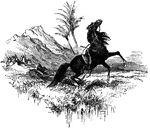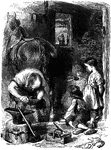
A Chariot of Iron
A horse-drawn chariot for soldiers, used to break enemy battalions. The wheels are equipped with blades…
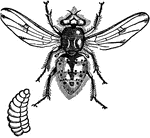
Gadfly of Horse
A gadfly, or Bot-fly, that lays its eggs on horses. After these eggs hatch on the skin, the larvae bore…
Acipenser Sturio
A type of Ganoid fish. Ganoid is an order of fishes included seven living genera, whose members are…
Amia Occidentalis
A type of Ganoid fish. Ganoid is an order of fishes included seven living genera, whose members are…

Horse Leech
The horse leech, similar to the medicinal leech, feeds chiefly on earthworms and on other leeches.

Human Leg (Front View), and Comparative Diagrams showing Modifications of the Leg
This illustration shows a human leg (front view), and comparative diagrams showing modifications of…
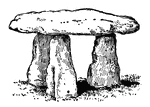
Lanyon Quoit Dolmen
Lanyon Quoit is a dolmen near Penzance. A dolmen, also known as a cromlech, portal tomb, portal grave…
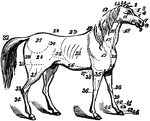
Horse
The anatomy of a horse. 1, ears; 2, forelock; 3, forehead; 4, eyes; 5, eye-pits; 6, nose; 7, nostril;…
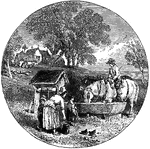
Horse Drinking
A horse drinking from a trough next to a well. An old woman is tending to the chickens and children.
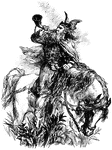
Norseman with Winged Helmet on Horseback
Man dressed as a caricature of a Viking with a winged helmet and blowing a horn.
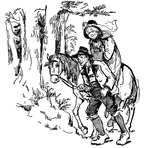
Adults and a Horse
An old woman sitting on a horse being led by an old man. They are traveling through the woods. A streamer…
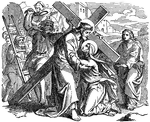
Jesus Carrying the Cross on the Way to Calvary
"They took Jesus therefore: and he went out, bearing the cross for himself, unto the place called The…
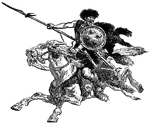
Hun Warrior on Horseback in Battle
Illustration of a Hun warrior riding on horseback, his mouth open as if to scream. The warrior has a…
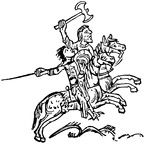
Two Anglo-Saxon Warriors on Horseback
Illustration of a drawing in The Harley Psalter, an illuminated manuscript of the second and third decades…
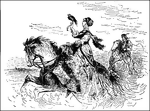
Falconry as Practiced by a Noblewoman of the Middle Ages on Horseback
A high-born, noblewoman rides a stallion while holding a falcon perched on her right hand. She is wearing…

Harrowing a Field for Farming in the Middle Ages
Two young men prepare the field using a simple harrow pulled by a horse. One man follows behind the…

The Creation of the World - Adam and Eve, Animals, Plants,
"In the beginning God created the heavens and the earth." Genesis 1:1 ASV Illustration of God sitting…
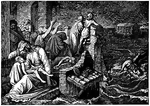
The Deluge - Noah's Ark Floats into the Rising Flood Waters as People Trapped on Land Watch in Horror
"And every living thing was destroyed that was upon the face of the ground, both man, and cattle, and…
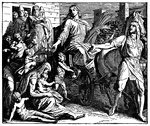
Joseph Collects Wheat as Governor of Egypt in Preparation for the Famine
"48 And he gathered up all the food of the seven years which were in the land of Egypt, and laid up…

Joseph Greets His Father Jacob and His Family
"And Joseph made ready his chariot, and went up to meet Israel his father, to Goshen; and he presented…
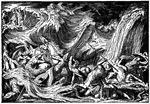
The Red Sea Swallows Pharaoh and His Army
"And Moses stretched forth his hand over the sea, and the sea returned to its strength when the morning…
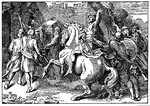
The Walls of Jericho Fall and the Israelites Enter the Promised Land
"So the people shouted, and the priests blew the trumpets; and it came to pass, when the people heard…

Absalom is Killed by Joab While Hanging in a Tree
"Then said Joab, I may not tarry thus with thee. And he took three darts in his hand, and thrust them…

Elijah Taken up to Heaven in a Chariot of Fire and a Whirlwind
"And it came to pass, as they still went on, and talked, that, behold, there appeared a chariot of fire,…

Jesus Carries His Cross and Comforts the Women Following Him
"And there followed him a great multitude of the people, and of women who bewailed and lamented him.…
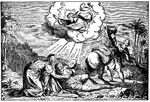
The Conversion of Paul - Saul Falls to the Ground
"And as he journeyed, it came to pass that he drew nigh unto Damascus: and suddenly there shone round…
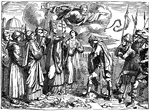
Pope Leo the Great Approaches Attila, King of the Huns, on the Battlefield
Illustration of Pope Leo, dressed in full papal costume and holding the primatial cross, approaches…
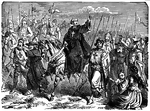
The Crusades being Preached by a Monk on Horseback
Illustration of a monk, riding horseback, surrounded by other Crusaders. Two other monks are in the…

Shackle Joint from the Exoskeleton of a Siluroid Fish
"A joint involving the principle of the shackle. Specifically, in anatomy, a kind of articulation found…
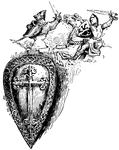
Medieval Shields from the 13th and 14th Centuries
Illustration including one large shield from the first half of the 13th century, bearing a decorative…

Bones of the Shoulder and Upper Extremity - Front View
"A, acromion; C, coracoid; CA, carpus; CL, clavicle; H, humerus; M, metacarpals; O, ventral surface…

Armadillo - Endoskeleton and Exoskeleton or Dermoskeleton
An illustration of a pichiciago, a small burrowing armadillo. The front half of the animal is covered…
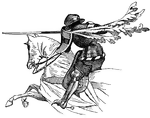
A Knight on Horseback, Wearing a Woman's Sleeve as a Favor
Illustration of a knight, riding a horse at full gallop, carrying a javelin and wearing full armor.…

A Single-Horse Sleigh or Cutter
"A vehicle, mounted on runners, for transporting persons on the snow or ice; sled. a, runners; b, shoes;…

Spancelling of a Horse
"...hobbled or fettered to a clog; said of a horse. When the bearing is properly depicted, a fore and…
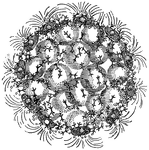
Sphaerozoum Ovodimare
"A genus compound radiolarians, typical of the family Sphaerozoidae, the protoplasm of which contains…

The Good Samaritan Binds the Wounds of an Injured Man
"But a certain Samaritan, as he journeyed, came where he was: and when he saw him, he was moved with…

Saul's Conversion on the Road to Damascus
"And as he journeyed, it came to pass that he drew nigh unto Damascus: and suddenly there shone round…



